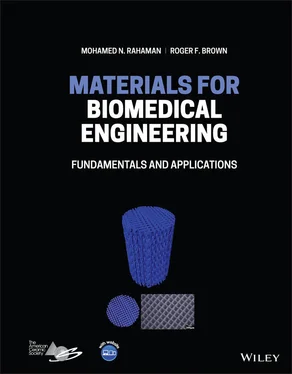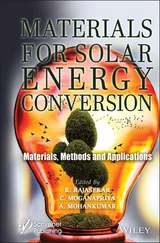Mohamed N. Rahaman - Materials for Biomedical Engineering
Здесь есть возможность читать онлайн «Mohamed N. Rahaman - Materials for Biomedical Engineering» — ознакомительный отрывок электронной книги совершенно бесплатно, а после прочтения отрывка купить полную версию. В некоторых случаях можно слушать аудио, скачать через торрент в формате fb2 и присутствует краткое содержание. Жанр: unrecognised, на английском языке. Описание произведения, (предисловие) а так же отзывы посетителей доступны на портале библиотеки ЛибКат.
- Название:Materials for Biomedical Engineering
- Автор:
- Жанр:
- Год:неизвестен
- ISBN:нет данных
- Рейтинг книги:4 / 5. Голосов: 1
-
Избранное:Добавить в избранное
- Отзывы:
-
Ваша оценка:
- 80
- 1
- 2
- 3
- 4
- 5
Materials for Biomedical Engineering: краткое содержание, описание и аннотация
Предлагаем к чтению аннотацию, описание, краткое содержание или предисловие (зависит от того, что написал сам автор книги «Materials for Biomedical Engineering»). Если вы не нашли необходимую информацию о книге — напишите в комментариях, мы постараемся отыскать её.
A comprehensive yet accessible introductory textbook designed for one-semester courses in biomaterials Materials for Biomedical Engineering: Fundamentals and Applications
Materials for Biomedical Engineering: Fundamentals and Applications
Materials for Biomedical Engineering — читать онлайн ознакомительный отрывок
Ниже представлен текст книги, разбитый по страницам. Система сохранения места последней прочитанной страницы, позволяет с удобством читать онлайн бесплатно книгу «Materials for Biomedical Engineering», без необходимости каждый раз заново искать на чём Вы остановились. Поставьте закладку, и сможете в любой момент перейти на страницу, на которой закончили чтение.
Интервал:
Закладка:
Copyright © 2022 by The American Ceramic Society. All rights reserved.
Published by John Wiley & Sons, Inc., Hoboken, New Jersey.
Published simultaneously in Canada.
All rights reserved. No part of this publication may be reproduced, stored in a retrieval system, or transmitted, in any form or by any means, electronic, mechanical, photocopying, recording or otherwise, except as permitted by law. Advice on how to obtain permission to reuse material from this title is available at http://www.wiley.com/go/permissions.
The right of Mohamed N. Rahaman and Roger F. Brown to be identified as the authors of this work has been asserted in accordance with law.
Registered Office John Wiley & Sons, Inc., 111 River Street, Hoboken, NJ 07030, USA
Editorial Office 111 River Street, Hoboken, NJ 07030, USA
For details of our global editorial offices, customer services, and more information about Wiley products visit us at www.wiley.com. Wiley also publishes its books in a variety of electronic formats and by print‐on‐demand. Some content that appears in standard print versions of this book may not be available in other formats.
Limit of Liability/Disclaimer of Warranty In view of ongoing research, equipment modifications, changes in governmental regulations, and the constant flow of information relating to the use of experimental reagents, equipment, and devices, the reader is urged to review and evaluate the information provided in the package insert or instructions for each chemical, piece of equipment, reagent, or device for, among other things, any changes in the instructions or indication of usage and for added warnings and precautions. While the publisher and authors have used their best efforts in preparing this work, they make no representations or warranties with respect to the accuracy or completeness of the contents of this work and specifically disclaim all warranties, including without limitation any implied warranties of merchantability or fitness for a particular purpose. No warranty may be created or extended by sales representatives, written sales materials or promotional statements for this work. The fact that an organization, website, or product is referred to in this work as a citation and/or potential source of further information does not mean that the publisher and authors endorse the information or services the organization, website, or product may provide or recommendations it may make. This work is sold with the understanding that the publisher is not engaged in rendering professional services. The advice and strategies contained herein may not be suitable for your situation. You should consult with a specialist where appropriate. Further, readers should be aware that websites listed in this work may have changed or disappeared between when this work was written and when it is read. Neither the publisher nor authors shall be liable for any loss of profit or any other commercial damages, including but not limited to special, incidental, consequential, or other damages.
Library of Congress Cataloging‐in‐Publication Data
Names: Rahaman, M. N., 1950‐ author. | Brown, Roger F., author.
Title: Materials for biomedical engineering : fundamentals and applications/ Mohamed N. Rahaman, Missouri University of Science and Technology, Rolla, Missouri, United States, Roger F. Brown, Missouri University of Science and Technolog, Rolla, Missouri, United States.
Description: First edition. | Hoboken, NJ : Wiley‐American Ceramic Society, 2022. | Includes bibliographical references and index.
Identifiers: LCCN 2021030672 (print) | LCCN 2021030673 (ebook) | ISBN9781119551089 (cloth) | ISBN 9781119551119 (adobe pdf) | ISBN9781119551096 (epub)
Subjects: LCSH: Biomedical materials. | Biomedical engineering.
Classification: LCC R857.M3 R34 2022 (print) | LCC R857.M3 (ebook) | DDC610.28–dc23
LC record available at https://lccn.loc.gov/2021030672LC ebook record available at https://lccn.loc.gov/2021030673
Cover Design: Wiley
Cover Image: © Mohamed N. Rahaman
Preface
Materials for Biomedical Applications places an emphasis on the fundamentals of biomaterials science and how these fundamentals are used, in practice, to modify and adapt various classes of materials for use as biomaterials in a variety of biomedical applications. Over the last several decades, advances in materials science, biological sciences, physical sciences, and engineering, along with an evolution in medical treatment, have led to the creation of biomaterials with a greater degree of sophistication and a considerable increase in range of use and efficacy. Millions of lives are now being improved or saved by the use of biomaterials in a wide variety of medical devices. As this importance of biomaterials to society continues to grow, so too will the significance of materials for biomedical applications, both as an academic field, an area of research to develop new or improved devices, and as an industry.
Our intention has been to write a textbook suitable for a one‐semester (or two‐quarter) course in biomaterials at the junior or senior undergraduate level, a course that is commonly a fixture in most biomedical engineering curricula at many universities. The book should also provide a useful introductory or reference resource for graduate students and practicing scientists and engineers in the field of biomedical engineering. Biomaterials is an interdisciplinary field and practitioners of biomaterials science often enter the field from a number of other fields. It is hoped that the emphasis of the book on fundamentals should provide a common ground for equipping students and practitioners with a background for understanding how the properties of biomaterials arise and how to design and create new biomaterials. The book assumes a knowledge of introductory physics and chemistry courses normally taught at most universities. Knowledge from introductory materials science and biological sciences courses is useful but it not a requirement, since appropriate principles of materials science, engineering, and biological sciences are considered in the earlier chapters of the book.
The overall arrangement of the topics covered in the book begins with an introductory overview of biomaterials and the biomaterials field. Following this, we discuss the relationship between the composition, structure and properties of materials, which is fundamental to the field of materials science and is critical to understanding how to select and design biomaterials for specific applications. Then specific classes of materials used as biomaterials, metals, ceramics, polymers (including synthetic and natural polymers and hydrogels) and composites, are considered from the point of view of how their composition and structure can be modified and manipulated to control their properties. As the ability of a biomaterial to degrade or not is a key property that influences its performance in vivo , we discuss factors that influence the degradation of biomaterials in the physiological environment. This is followed by a discussion of biocompatibility phenomena, that is, the effect of appropriate responses from cells and tissues of the body on the ability of an implanted biomaterial to perform, which is the most critical factor that determines the biomaterial’s success in vivo . The final part of the book, discussing the applications of biomaterials, is where we see how the principles of materials science, engineering, and biology covered in the earlier chapters are used, in practice, to modify and adapt the various classes of materials for use as biomaterials in a variety of biomedical applications. Because a wide range of applications cannot be adequately covered at a level compatible with the intention of this book, we limit coverage to applications broadly grouped into four areas. These areas, which represent a significant cross section of the biomedical field and biomedical industry, are the repair of hard tissues, repair of soft tissues, tissue engineering and regenerative medicine, and drug delivery.
Читать дальшеИнтервал:
Закладка:
Похожие книги на «Materials for Biomedical Engineering»
Представляем Вашему вниманию похожие книги на «Materials for Biomedical Engineering» списком для выбора. Мы отобрали схожую по названию и смыслу литературу в надежде предоставить читателям больше вариантов отыскать новые, интересные, ещё непрочитанные произведения.
Обсуждение, отзывы о книге «Materials for Biomedical Engineering» и просто собственные мнения читателей. Оставьте ваши комментарии, напишите, что Вы думаете о произведении, его смысле или главных героях. Укажите что конкретно понравилось, а что нет, и почему Вы так считаете.












